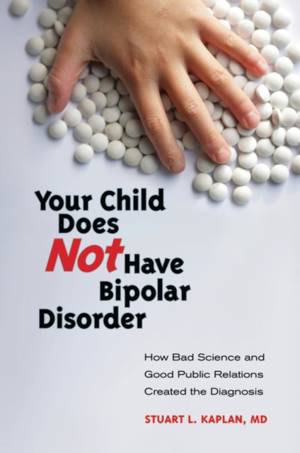
- Retrait gratuit dans votre magasin Club
- 7.000.000 titres dans notre catalogue
- Payer en toute sécurité
- Toujours un magasin près de chez vous
- Retrait gratuit dans votre magasin Club
- 7.000.0000 titres dans notre catalogue
- Payer en toute sécurité
- Toujours un magasin près de chez vous
Your Child Does Not Have Bipolar Disorder
How Bad Science and Good Public Relations Created the Diagnosis
Stuart Kaplan
76,45 €
+ 152 points
Description
An eminent child psychiatrist provides an insider's, whistle-blowing perspective on the promotion of a diagnostic entity that does not exist.
Your Child Does Not Have Bipolar Disorder: How Bad Science and Good Public Relations Created the Diagnosis examines this diagnostic fad through a variety of lenses. Author Stuart L. Kaplan, MD, draws heavily on his forty years of experience as a clinician, researcher, and professor of child psychiatry to make the argument that bipolar disorder in children and adolescents is incorrectly diagnosed and incorrectly treated. As Dr. Kaplan explains, the dramatic rise in this particular diagnosis is not based on scientific evidence, nor does it reflect any new discovery or insight about the etiology or treatment of the disorder. In fact, the opposite is the case: the scientific evidence against the existence of child bipolar disorder is so strong that it is difficult to imagine how it has gained the endorsement of anyone in the scientific community. Your Child Does Not Have Bipolar Disorder: How Bad Science and Good Public Relations Created the Diagnosis explains to parents and professionals the faulty reasoning and bad science behind the misdiagnosis of childhood bipolar disorder. Dr. Kaplan critiques the National Institute of Mental Health, academic child psychiatry, the pharmaceutical industry, and the media for their respective roles in advocating this diagnosis. He describes very clearly what the children and adolescents actually do have, explains how it should be treated, and provides real-life clinical scenarios and approaches to treatment that work.Spécifications
Parties prenantes
- Auteur(s) :
- Editeur:
Contenu
- Nombre de pages :
- 208
- Langue:
- Anglais
- Collection :
Caractéristiques
- EAN:
- 9780313381348
- Date de parution :
- 03-03-11
- Format:
- Livre relié
- Format numérique:
- Ongenaaid / garenloos gebonden
- Dimensions :
- 165 mm x 236 mm
- Poids :
- 476 g

Les avis
Nous publions uniquement les avis qui respectent les conditions requises. Consultez nos conditions pour les avis.






